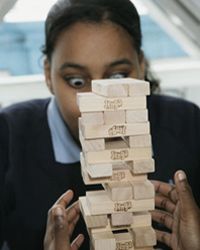Humans are natural-born structural engineers. If you find that hard to believe, watch a small child play with a set of simple wooden blocks. With no outside instruction -- and through lots of energetic trial and error -- he or she will eventually learn that the most stable way to build upward is to place a horizontal beam across two vertical columns.
The child's intuitive logic is the same that inspired the Mycenaean architects of the 13th century B.C.E. to construct the famous Lion Gate out of two stone columns and a slightly arched beam. It's the same structural savvy that told the ancient Egyptians that if you want to build something tall out of stone, you need to start wide at the base. And it's that same natural-born engineer in all of us that says, "Dude, if you want to win at Jenga, don't leave a single support at the bottom of the tower!"
Advertisement
Jenga is one of the most popular games in the world, third only to Monopoly and Scrabble in the number of units sold [source: Little]. The object of the game is simple: You start with a stack of 54 blocks -- three blocks across, 18 levels high. Each level of blocks should be perpendicular to the level below it. Each player must remove a block from near the bottom of the tower and place it on the top using only one hand at a time. Eventually the tower becomes dangerously unstable. If you're the one who finally knocks it over, you lose.
Jenga was invented by Leslie Scott, a British citizen born and raised in Kenya and Tanzania. (Jenga means "build" in Swahili.) Scott played the game with her family in Africa for years; she eventually left a job with Intel to launch Jenga at a 1983 toy fair, where it became an instant gaming phenomenon [source: Little].
Part of Jenga's charm is its simplicity; nothing but wooden blocks and gravity. But even this simple game can teach us a lot about the more complex world of structural engineering. Buildings, after all, are vulnerable to the same forces that can topple a Jenga tower -- forces like loads, tension, compression, torsion and more. An accidental bump of the game table is an excellent scale version of a catastrophic earthquake.
Let's start our exploration of the structural engineering of Jenga with a look at loads.


